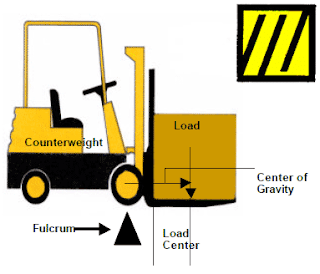Senin, 01 Agustus 2011
HOW FORKLIFTS SAFELY CARRY AND LIFT HEAVY LOADS
A forklift is counterbalanced and operates on a teeter-totter principle. A load on a beam (the forks) supported by a fulcrum (the front wheels) is counterbalanced by a weight on the other end of the beam (the forklift body and counterweight built into it). Forklifts are designed and manufactured deliberately unbalanced! The load of the forks must be balanced by the weight of the lift truck in order for this principal to work. We need a proper load to balance our “teeter-totter”.
You balance at both ends! A properly loaded lift truck does not exceed the rated capacity of the truck as listed on the trucks data plate.
Minggu, 31 Juli 2011
FORKLIFT, HEALTH AND SAFETY (OHS CODE)-01
Assessing hazards
Employers must assess their work sites to identify existing and potential hazards before work begins, and must eliminate or control the identified hazards. (OHS CODE, SECTION 7)
Appropriate equipment
Employers must ensure that forklift used in the workplace are of sufficient size, strength and design to perform the function for which they are intended. (OHS CODE, SECTION 12)
Manufacturer's specifications
Employers must ensure that forklifts are iperated and maintained in accordance with manufacturer's specifications, and that any modifications are done in accordance with manufacturer's specifications or specifications certified by professional engineer. (OHS CODE, SECTION 12)
FORKLIFT, HEALTH AND SAFETY (LEGISLATION)
 Alberta's Occupational Health and Safety (OHS) Act. Regulations and Code have general and specific requirements related to the operation of forklifts.
Alberta's Occupational Health and Safety (OHS) Act. Regulations and Code have general and specific requirements related to the operation of forklifts.In many instances thr legislation sets out requirements for the safe use of "equipment" or "powered mobile equipment". All forklifts meet the definition of "equipment" and all powered forklifts meet the definition of "powered mobile equipment". Hence requirements relating to "equipment" and "powered mobile equipment" apply to forklift.
Jumat, 29 Juli 2011
EKSCAVATOR, SAFE SYSTEM OF WORK
 For an operation involving the use of an excavator, the proprietor/contractor, in consultation with the management personnel and workers, should carry out a detailed analysis of the operation so as to devise a system of work that is safe and without risk to health to workers. A system of work should lay down proper and safe work method and procedures for workers to follow.
For an operation involving the use of an excavator, the proprietor/contractor, in consultation with the management personnel and workers, should carry out a detailed analysis of the operation so as to devise a system of work that is safe and without risk to health to workers. A system of work should lay down proper and safe work method and procedures for workers to follow.Workers concerned should be given knowledge of details of the system of work. Where necessary, the proprietor/contractor should arrange suitable training for the workers to impress upon them the importance of following the work method and procedures in the system of work.
Establishing a safe system or work
Before commencement of work with an excavator, the proprietor/contractor should identify all potential hazards associated with the work to be performed, so as to assess the risk. The following factors should be considered :
- type of excavator used and type of protective structure installed
- limitations and restrictions of the excavator
- ground profile and condition at the work location
- proximity hazard at the work location
- work requirements ; and
- competence of the work team
Kamis, 28 Juli 2011
Rabu, 27 Juli 2011
FORKLIFT, HEALTH & SAFETY (OHS CODE)-02
 Visual inspection
Visual inspectionForklift operators must complete a visual inspection of a powered forklift and the surrounding area to ensure that the forklift is in safe operating condition and that no worker, including the operator, is endangered when the forklift is started up (OHS CODE, SECTION 257)
Equipment inspection
Employers must ensure thet powered forklift are inspected by a competent worker for defects and conditions that are hazardous or may create a hazard. If an inspection indicates that a forklift is hazardous or potentially hazardous, an employer must ensure that the health and safety of a wroker who may be exposed to the hazard is protected immediately and the forklift is not operated until the defect is repaired or the condition is corrected. Alternatively, if the forklift is potentially hazardous but can be operated safely temporarily, an employer must ensure that the operator is made aware of the potential hazard and the defect or condition is repaired as soon as reasonably practicable (OHS CODE, SECTION 260)
Unattended controls
Workers operating a powered forklift must not leave the controls of the forklift unattended unless the forklift is secured against unintentional movement by an effective method of immobilizing the forklift (OHS CODE, SECTION 263)
Langganan:
Komentar (Atom)




